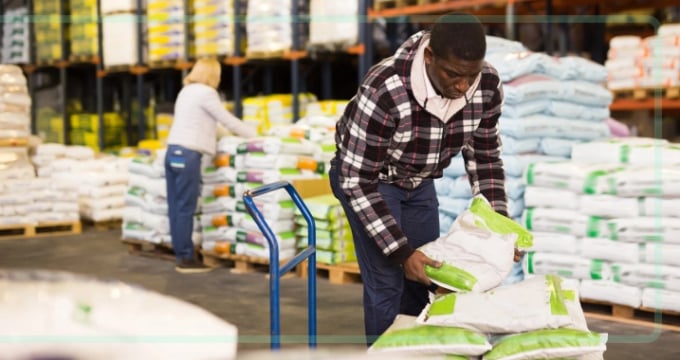June 8, 2025 | 05:38 GMT +7
June 8, 2025 | 05:38 GMT +7
Hotline: 0913.378.918
June 8, 2025 | 05:38 GMT +7
Hotline: 0913.378.918

Natural gas prices are at historic highs, and natural gas accounts for up to 90% of the operating cost of producing fertilizer. Photo: JackF via Getty Images
Fertilizer prices last week were nearly 10% higher than the week before according to Green Markets North America Fertilizer Price Index, the highest price point ever recorded. Prices are now 40% higher than a month ago, before the invasion of Ukraine.
The surge in fertilizer prices reveals how dependent many of the world's farms are on Russian exports. Countries already afflicted by food insecurity now risk further production bottlenecks and food shortages at the worst possible time.
Russian fertilizers are everywhere
The farming industry has been hit hard by the war and the political reaction in Russia to Western sanctions. Russia was the world’s top exporter of fertilizers in 2019, according to data from the Observatory of Economic Complexity, when Russia’s trade volume in fertilizer stood at nearly $9 billion.
Russia and neighboring Belarus, which has also been hit by sanctions, are key exporters of several critical fertilizing compounds, including urea and potash, but curtailed exports of these products has caused prices to soar. Surging fertilizer prices have also been aggravated by higher costs for natural gas, a critical feedstock in producing nitrogen-based fertilizer, amid a U.S. ban of Russian oil imports and discussions in Europe to decouple from Russian energy.
International shipping companies have largely suspended their activities in Russia, bringing global trade to a standstill. And in early March, Russian officials told fertilizer producers in the country to slow their exports in retaliation to Western sanctions.
The soaring costs of fertilizers, and other key agricultural commodities like wheat used for cow feed, could have knock-on effects throughout the world. The high prices might lead to severe bottlenecks, severely reducing agricultural production and aggravating what economists have already designated as a global food crisis.
A global food supply crisis
Before the invasion of Ukraine, the UN’s Food and Agriculture Organization had already warned that “acute food insecurity” was plaguing dozens of countries spanning Latin America, central Africa, the Middle East, and central Asia due to conflict and erratic environmental conditions. The economic fallout of the Ukraine War could further add to this insecurity.
“Ukraine has only compounded a catastrophe on top of a catastrophe,” David M. Beasley, executive director of the UN World Food Program, recently told The New York Times, adding that the current levels of food insecurity have not been seen since World War II.
The effects of trapped food products in Ukraine and Russia, both of which are global bread baskets, are already being felt in the world's more vulnerable countries. Around 40% of Ukraine's wheat and corn exports are intended for the Middle East and Africa, according to the UN International Fund for Agricultural Development (IFAD), which has expressed concern over how massive price swings for staple crops could affect stability in the region.
“I am deeply concerned that the violent conflict in Ukraine, already a catastrophe for those directly involved, will also be a tragedy for the world’s poorest people living in rural areas who cannot absorb the price hikes of staple foods and farming inputs that will result from disruptions to global trade,” said Gilbert F. Houngbo, President of IFAD.
“We are already seeing price hikes and this could cause an escalation of hunger and poverty with dire implications for global stability," Houngbo said.
Brazil, the world’s largest importer of fertilizers, was already expecting low crop yields this year due to an ongoing drought, and is now scrambling to increase domestic production of fertilizing products as it looks to plug the gap left by Russia.
Larger producers may be able to weather the storm of higher fertilizer prices, but smallholder and family-run farms who cannot afford higher costs can be hit hard by market volatility of these key products, Svein Tore Holsether, the CEO and president of Norwegian fertilizer giant Yara International, told Fortune at last November’s COP26 climate conference.
Natural gas prices were spiking last fall as demand roared back despite low inventory, causing a surge of fertilizer prices.
"I’m afraid we’re going to have a food crisis," Holsether said at the time.
(finance)

(VAN) With the war ongoing, many Ukrainian farmers and rural farming families face limited access to their land due to mines and lack the financial resources to purchase needed agricultural inputs.

(VAN) Vikas Rambal has quietly built a $5 billion business empire in manufacturing, property and solar, and catapulted onto the Rich List.

(VAN) Available cropland now at less than five percent, according to latest geospatial assessment from FAO and UNOSAT.

(VAN) Alt Carbon has raised $12 million in a seed round as it plans to scale its carbon dioxide removal work in the South Asian nation.

(VAN) Attempts to bring down the price of the Japanese staple have had little effect amid a cost-of-living crisis.

(VAN) Fourth most important food crop in peril as Latin America and Caribbean suffer from slow-onset climate disaster.

(VAN) Shifting market dynamics and the noise around new legislation has propelled Trouw Nutrition’s research around early life nutrition in poultry. Today, it continues to be a key area of research.